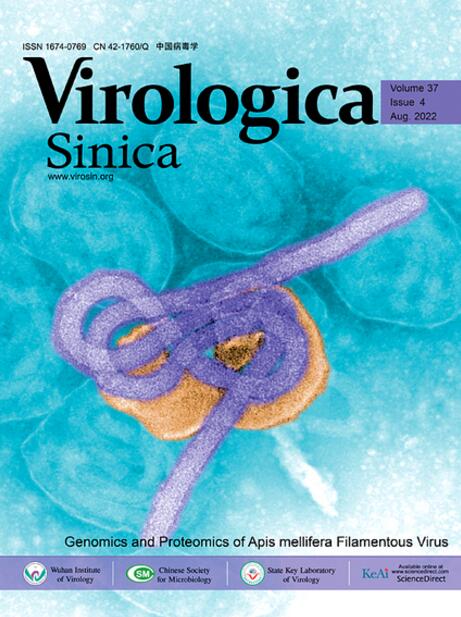sars - cov - 23cl蛋白酶通过裂解气皮蛋白D抑制焦亡。
IF 4
3区 医学
Q1 Medicine
引用次数: 0
摘要
严重急性呼吸系统综合征冠状病毒 2(SARS-CoV-2)是 2019 年新型冠状病毒病的病原体,可在全球范围内引起急性呼吸道症状甚至死亡。然而,人们对其免疫逃逸机制和病毒致病机理仍然知之甚少。在这里,我们报告了 SARS-CoV-2 3C-like (3CL) 蛋白酶特异性地裂解 Q29 和 Q193 处的 gasdermin D (GSDMD),产生两个 N 端片段,即 GSDMD1-29 和 GSDMD1-193。我们还发现,SARS-CoV-2 感染会诱导 GSDMD 的裂解。然后,我们证明了 GSDMD 的裂解能力取决于 3CL 蛋白酶的蛋白酶活性。有趣的是,与被caspase-1裂解的GSDMD1-275片段不同,GSDMD1-29和GSDMD1-193不会引发热休克或抑制SARS-CoV-2的复制。此外,各种 RNA 病毒蛋白酶对裂解 Q29 和 Q193 处的 GSDMD 有不同的偏好。我们的研究结果揭示了 SARS-CoV-2 和其他 RNA 病毒抑制热蛋白沉积的机制,突出了 3CL 蛋白酶在免疫逃避和病毒复制中的关键作用。本文章由计算机程序翻译,如有差异,请以英文原文为准。
The SARS-CoV-2 3CL protease inhibits pyroptosis through the cleavage of gasdermin D
Severe acute respiratory syndrome coronavirus 2 (SARS-CoV-2), the causative agent of novel coronavirus disease 2019, can cause acute respiratory symptoms and even death globally. However, the immune escape mechanism and viral pathogenesis remain poorly understood. Here, we report that the SARS-CoV-2 3C-like (3CL) protease specifically cleaves gasdermin D (GSDMD) at Q29 and Q193, producing two N-terminal fragments, GSDMD1–29 and GSDMD1–193. We also found that SARS-CoV-2 infection induced the cleavage of GSDMD. Then, we demonstrated that the ability to cleave GSDMD was dependent on the protease activity of the 3CL protease. Interestingly, unlike the GSDMD1–275 fragment cleaved by caspase-1, GSDMD1–29 and GSDMD1–193 did not trigger pyroptosis or inhibit SARS-CoV-2 replication. Additionally, various RNA viral proteases display different preferences for cleaving GSDMD at Q29 and Q193. Our findings reveal a mechanism by which SARS-CoV-2 and other RNA viruses inhibit pyroptosis, highlighting the critical role of the 3CL protease in immune evasion and viral replication.
求助全文
通过发布文献求助,成功后即可免费获取论文全文。
去求助
来源期刊

Virologica Sinica
Biochemistry, Genetics and Molecular Biology-Molecular Medicine
CiteScore
7.70
自引率
1.80%
发文量
3149
期刊介绍:
Virologica Sinica is an international journal which aims at presenting the cutting-edge research on viruses all over the world. The journal publishes peer-reviewed original research articles, reviews, and letters to the editor, to encompass the latest developments in all branches of virology, including research on animal, plant and microbe viruses. The journal welcomes articles on virus discovery and characterization, viral epidemiology, viral pathogenesis, virus-host interaction, vaccine development, antiviral agents and therapies, and virus related bio-techniques. Virologica Sinica, the official journal of Chinese Society for Microbiology, will serve as a platform for the communication and exchange of academic information and ideas in an international context.
Electronic ISSN: 1995-820X; Print ISSN: 1674-0769
 求助内容:
求助内容: 应助结果提醒方式:
应助结果提醒方式:


